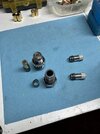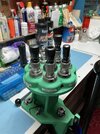Buzznrose
Member
Just to clarify, I use mostly RCBS and Hornady dies. I have Lee FCD’s on my .308, .223, ..357, 9MM, and 10MM die sets.
They work for me.
They work for me.
This ^^^^It might squeeze them down enough to chamber, but is that "fixed?
They are too fat somewhere or they would chamber.
So, are the bullets oversized? Are they seated crooked? Did you over crimp and bulge the round at the crimp? I'd rather go after those possible issues before I just squeezed the rounds to fit, as that can cause its own issues sometimes.
An old Lee FCD post of mine.
From the link:
"The FCD will squeeze it down and make it fit, and the new reloader pats themselves on the back and calls it good, whereas if they hadn't used it they would eventually run into a problem with a tight (Within spec but tight) chamber and learn to fix the issues by adjustment of dies/user improvement of starting bullets straighter. (Even sliding sleeve seaters do a better job of seating bullets straight if they start out straighter. I have proven that to myself. They cannot totally fix a sloppy start of the bullet.)
A lot of pistol gamers use them so everything will absolutely fit and not cause a stoppage during a competition, as the penalties are so severe for a stoppage. Some use a case gauge and check all rounds, some do both. Things happen, fat bullets, got one a little crooked being in a hurry loading 500 or 1K rounds for matches, and the FCD will make sure you don't have a stoppage due to a fat reload.
I look at the FCD as an "advanced" reloaders tool, not a beginners tool.
I'll say again, if you are feeling a fair amount of resistance of your reloads in the carbide ring of the FCD on a lot/all of your rounds, stop and investigate, because something is amiss, even if it is simply an undersized FCD. You should be feeling very light to almost no resistance in the carbide ring."
I'll say again, if you are feeling a fair amount of resistance of your reloads in the carbide ring of the FCD on a lot/all of your rounds, stop and investigate, because something is amiss, even if it is simply an undersized FCD. You should be feeling very light to almost no resistance in the carbide ring."
"All my autos" would seem to imply more than one.
Which of your auto cartridges, besides the 9mm, isn't a "straight wall cartridge?"
I believe the question posed to you was specifically, "Which cartridge does the 9mm FCD bulge bust"...which I don't think you've answered
I believe that is an unfair statement. @9mmepiphany and I in particular have both given positives about the Lee FCD for pistols,I wish the moderators had not virtually forbidden any positive comments on this tool. It is useful when applied correctly to a number of loading methods. Such a shame it gets a bad rap based on incorrect usage.

With all respect to you and @9mmepiphany (and I mean it, you have a difficult role) when you guys say something, we have to figure out what you mean and what you might mean. It's the nature of the relationship. Not sure if I agree with @GeoDudeFlorida but I certainly know where he's coming from.I believe that is an unfair statement. @9mmepiphany and I in particular have both given positives about the Lee FCD for pistols,
as well as the perceived negative. Same as any other piece of equipment. I bought two, tried them out, discontinued use of them. YMMV.
I'm not a pistol gamer, or I might use them as another failsafe against fit related feeding/chambering issues since the penalty that results
is so large during a competition. I don't know, might just use gauge blocks.
If you found 5 in 500 built for a shoot would you break those 5 down or run those 5 through an fcd and use them for warm up? I also don't know if one gets enough feedback on a progressive to know if it's a hard case sizing or being sized by the fcd. The use case is so varied its hard to pin down.I believe that is an unfair statement. @9mmepiphany and I in particular have both given positives about the Lee FCD for pistols,
as well as the perceived negative. Same as any other piece of equipment. I bought two, tried them out, discontinued use of them. YMMV.
I'm not a pistol gamer, or I might use them as another failsafe against fit related feeding/chambering issues since the penalty that results
is so large during a competition. I don't know, might just use gauge blocks.
And, incidentally, I do not use the FCD for 45acp because I now use a Redding micrometer adjustable cause it's cool looking
I actually meant the micrometer taper crimp die, but have the seater too. I confess to being a micrometer fan boy. Even started a thread about "why no micrometer expander?"That is the die that enabled me to put my FCD on the shelf, not because its cool looking, but because it's tolerances are so tight that they seat the bullets straight every time. Cast bullets are slightly oversized and a little tilt gave me problems. The micrometer seating is definitely a bonus.
I will say though, when I used a RCBS seater with the FCD, if it did do bad things to my loads, I couldn't shoot the difference and never got any greater amount of leading. YMMV.

Not that you're asking me, but over the years the more I tried to create the "perfect" cartridge, the fewer anomalies I'd accept. I now accept none. It's the one in 99.If you found 5 in 500 built for a shoot would you break those 5 down or run those 5 through an fcd and use them for warm up? I also don't know if one gets enough feedback on a progressive to know if it's a hard case sizing or being sized by the fcd. The use case is so varied its hard to pin down.
I certainly meant no offense. This statement caught me by surprise:I believe that is an unfair statement. @9mmepiphany and I in particular have both given positives about the Lee FCD for pistols,
as well as the perceived negative. Same as any other piece of equipment. I bought two, tried them out, discontinued use of them. YMMV.
I'm not a pistol gamer, or I might use them as another failsafe against fit related feeding/chambering issues since the penalty that results
is so large during a competition. I don't know, might just use gauge blocks.
I don’t recall seeing a preemptive admonition like that. I don’t necessarily disagree but what I was actually referring to was the absence of a similar admonition on the other side, “I tried it once and it’s total garbage.” I think both statements should require some explanation. Maybe that’s implied and I misconstrued the statement. If so, I do apologize.I'd really prefer that this thread not turn into a thread of biased opinion sharing (I've used it for years and it's great) and hope that members can couple their opinion with some descriptive comparative experience
So you take them appart? For blamo I'm not doing that. For precision rifle I would...Not that you're asking me, but over the years the more I tried to create the "perfect" cartridge, the fewer anomalies I'd accept. I now accept none. It's the one in 99.
ALL my ammo is blamo (Jelly Roll's new single) and if that was called for, absolutely, without question.So you take them appart? For blamo I'm not doing that. For precision rifle I would...
You should take a look at the recent thread I started asking about a powder suggestions for multiple cartridges.I don’t recall seeing a preemptive admonition like that.
My admonition against "bias opinions without support " was intended to apply to both sides of the argument.I don’t necessarily disagree but what I was actually referring to was the absence of a similar admonition on the other side, “I tried it once and it’s total garbage.” I think both statements should require some explanation. Maybe that’s implied and I misconstrued the statement. If so, I do apologize.
Good thing you weren't watching his review of the Z06 Corvette!After watching fortunecookie’s FCD video all I know is I want one. It’s in my cart!
It would have to be a red 2003 z06 fixed roof coupe!Good thing you weren't watching his review of the Z06 Corvette!
Yes, a fine looking car. Better looking than the drop tops.It would have to be a red 2003 z06 fixed roof coupe!
